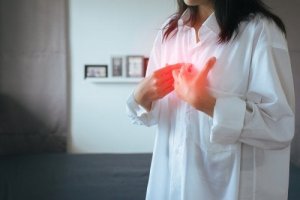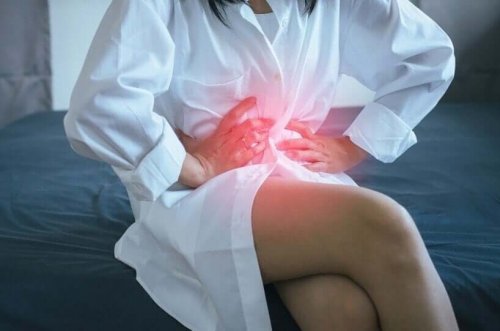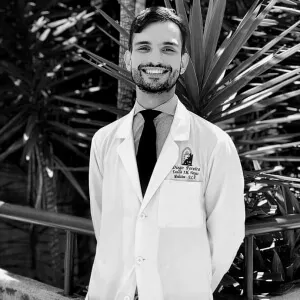Gastroesophageal Reflux Disease (GERD): Symptoms and Treatment

Gastroesophageal reflux disease (GERD) is characterized by the spontaneous passage of gastric contents into the esophagus without there being a cause that provokes it. On the other hand, physiological gastroesophageal reflux is mainly due to the transient and spontaneous lower esophagus sphincter relaxation due to the distension of the stomach.
This condition affects the quality of life of people who suffer from it. However, to consider it a pathology, symptoms must be sufficiently intense. Therefore, gastroesophageal reflux is a generally chronic condition with a good prognosis. In addition, its symptoms vary in intensity and it’s characterized by intermittent remissions periods.
The causes of gastroesophageal reflux disease

Gastroesophageal reflux disease occurs due to a sphincter malfunction that regulates the passage of acidic juices.
The manifestation of GERD depends on many factors. However, the most important one is the malfunction of the lower esophageal sphincter. Furthermore, factors that promote gastroesophageal reflux include:
- Esophageal motility
- Upper esophageal sphincter
- Esophageal clarification mechanisms and stomach contents
In many cases, gastroesophageal reflux is usually associated with hiatal hernia. This is because hiatal hernia promotes reflux.
Symptoms
Gastroesophageal reflux disease has many symptoms. The condition can range from the mere manifestation of symptoms to the coexistence of esophagitis. Also, complications such as stenosis, esophageal ulcer, or Barrett’s esophagus may occur, although less frequently.
The variability of symptoms depends on factors such as the duration of gastroesophageal reflux disease episodes and the volume and aggressiveness of reflowed material. In addition, medical professionals must take into account how long this material has been in contact with esophageal mucus.
Overall, the most common symptoms are:
- Heartburn. This is the most characteristic symptom. It’s a burning sensation rising from the epigastrium.
- Acid regurgitation. This is the second most common symptom. It involves the spontaneous passing of gastric content to the mouth. This is favored by certain positions or by increased abdominal pressure.
- Central chest pain. This may be acute or sudden, caused by esophageal spasms. You may suspect that the source of pain is GERD when it’s related to food intake and not with exertion.
- Dysphagia or choking.
- Odynophagia. Painful swallowing. However, this is not a common symptom of gastroesophageal reflux disease. Nevertheless, if it manifests, it may indicate the presence of esophagitis.
Typical symptoms of GERD have high diagnostic reliability. The manifestation of these symptoms leads to an almost certain diagnosis and indicate a treatment without the need for additional diagnostic tests such as endoscopy. However, if the patient presents worrying symptoms or doesn’t respond to conventional treatment, a esophagogastroduodenoscopy should be performed.
Treatment of gastroesophageal reflux disease
The treatment of gastroesophageal reflux disease is aimed at relieving symptoms and curing esophagitis. In addition, medical professionals treat and prevent possible complications.
Other treatment options include lifestyle modifications, hygiene and dietetic measures, medications, and, in some extreme cases, surgery.
Hygiene and dietary measures

A healthy diet is crucial for the control of gastroesophageal reflux disease. In general, it’s advisable to eat light and avoid potential irritants.
Lifestyle and hygiene and dietary measures should be personalized for each patient according to risk factors that exist in each case. However, the clinical response to the changes should be taken into account.
It’s advisable to quit smoking and to reduce alcohol consumption, as well as to lose weight in the case of overweight or obese patients.
Another measure that’s implemented is bed headboard elevation. Doctors also recommend:
- Avoiding heavy meals, as it’s better to eat more frequent, lighter meals.
- Detecting and avoiding foods that trigger symptoms.
- Controlling stress.
- Regular physical exercise.
- Spending enough time chewing food.
You may also enjoy the following article: Three Habits that Will Help Control Your Gastritis
Medications
Medical treatment is based on the inhibition or neutralization of gastric acid secretion.
Proton-pump inhibitors are among the groups of commonly used drugs for the treatment of GERD. These drugs cause the total inhibition of gastric secretion. They also relieve symptoms, heal esophagitis, and control recurrences.
Meanwhile, antacids effectively and quickly relieve heartburn. On the other hand, prokinetics are useful when regurgitation predominates. Also, H2 blockers produce a partial inhibition of gastric acid secretion. Medical professionals indicate these drugs for the treatment of GERD when the patient doesn’t suffer from esophagitis.
Is this condition affecting your quality of life?
As you may have seen, various factors can cause it or make it worse. However, there are many treatment options. Talk to your doctor to find out which is best for you.
All cited sources were thoroughly reviewed by our team to ensure their quality, reliability, currency, and validity. The bibliography of this article was considered reliable and of academic or scientific accuracy.
- Badillo R, Francis D. Diagnosis and treatment of gastroesophageal reflux disease. World J Gastrointest Pharmacol Ther. 2014;5(3):105–112. doi:10.4292/wjgpt.v5.i3.105.
- Tack J., Pandolfino JE., Pathophysiology of gastroesophageal reflux disease. Gastroenterology, 2018. 154 (2): 277-288.
This text is provided for informational purposes only and does not replace consultation with a professional. If in doubt, consult your specialist.









